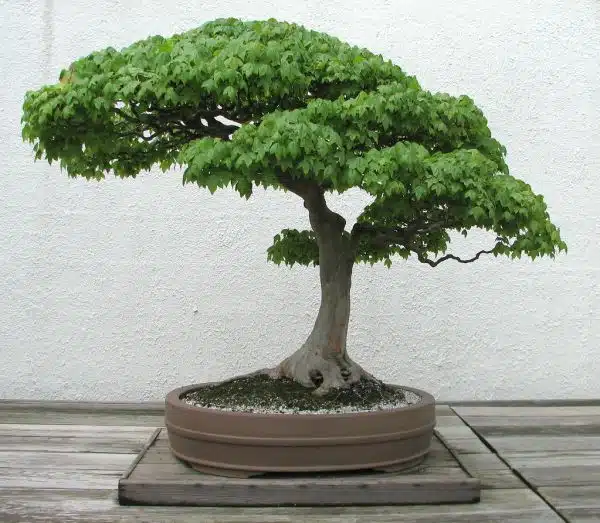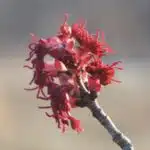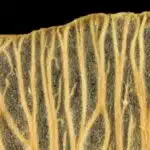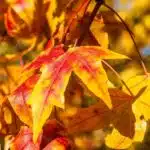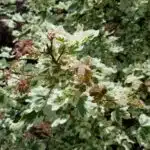Trident maple, also known as Acer buergerianum, is a deciduous tree that belongs to the family Sapindaceae. This species of maple is native to East Asia and grows well in temperate climates. The trident maple is an excellent choice for ornamental purposes due to its attractive foliage and beautiful bark texture. Its small size, resilience, and low maintenance requirements make it an ideal option for homeowners who want to add a touch of elegance to their landscape.
In this article, we will provide you with essential information on how to grow and care for trident maple, including the best planting locations, soil requirements, watering schedules, fertilization tips, pruning techniques and pests management. By following these guidelines provided by certified arborists or horticulturalists who have extensive experience in the cultivation of trident maples, you can ensure that your tree thrives in its environment and enhances the aesthetic appeal of your property. Whether you are a beginner or an experienced gardener looking for new insights into trident maple care, this article will equip you with all the knowledge necessary to create a healthy and vibrant tree that provides beauty and benefits for years to come.
Introduction To Trident Maple
Trident Maple, also known as Acer buergerianum, is a deciduous tree that belongs to the maple family. It is native to Japan, China, and Korea but has become a popular ornamental tree in many parts of the world. The tree is characterized by its distinctive three-lobed leaves and attractive bark that develops into shades of gray or tan as it matures.
Planting trident maple comes with several benefits. Apart from its aesthetic appeal, this tree species provides shade during summer months and brightens up landscapes in autumn with its vibrant foliage colors. Additionally, trident maple is low maintenance once established and can tolerate urban pollution and drought conditions.
Interesting facts about trident maple include that it was first introduced to the United States in 1896 by a plant explorer named Charles Sargent. Also, it has been used for centuries in traditional Chinese medicine for treating various ailments such as high blood pressure and asthma. Understanding the botanical characteristics of trident maple is crucial for its successful growth and care. Let us delve into these aspects in detail below.
Understanding The Botanical Characteristics Of Trident Maple
Trident maple, scientifically known as Acer buergerianum, is a deciduous tree that belongs to the family Sapindaceae. This species is native to East Asia and is commonly found in Japan, China, Korea, and Taiwan. The botanical classification of trident maple indicates that it can grow up to 30 feet tall with a spread of 20-25 feet.
Trident maple has an upright growth habit with a dense crown that provides ample shade. It has a slow to moderate growth rate and can live for over 100 years if given proper care. Its leaves are three-lobed and have serrated edges, and they turn yellow, orange or red in fall before falling off. The flowers are small and greenish-yellow in color and bloom during spring.
To grow trident maple successfully, it is necessary to understand its botanical characteristics and growth habits. Here are some essential things you should know:
Soil requirements: Trident maples prefer well-draining soil with a slightly acidic pH level (between 6.0-6.5). They are not tolerant of wet soil conditions or soil with high alkaline levels.
Sunlight exposure: These trees require full sun exposure for optimal growth but can also tolerate partial shade.
Watering needs: Adequate watering is crucial during the first few years after planting to help establish a strong root system. Once established, trident maples can withstand periods of drought but will do best with regular watering.
Fertilization: Fertilizing your trident maple annually during its growing season with a balanced slow-release fertilizer will help promote healthy growth and leaf development.
Understanding these essential factors about trident maple will help you cultivate healthy trees that thrive in your garden or landscape design project while minimizing any potential issues caused by incorrect planting methods or maintenance practices. In the next section, we will delve deeper into choosing the right location for planting trident maple.
Choosing The Right Location For Planting Trident Maple
When it comes to growing and caring for trident maple, choosing the right location for planting is crucial. A suitable location will ensure that the tree grows healthily and reaches its full potential. For example, a trident maple planted in an area with too much shade may struggle to grow and develop properly. On the other hand, a trident maple planted in an area with excessive sunlight may suffer from leaf scorch or heat stress.
To determine the best location for planting your trident maple, consider its sun and shade preferences. Tridents maples prefer partial shade to full sun exposure. Ideally, they should be planted in an area that receives morning or afternoon sun but is shaded during the hottest part of the day. This will protect them from direct sunlight and prevent their leaves from drying out.
Landscaping tips suggest that when selecting a location for planting your trident maple, look for areas with well-draining soil that are not prone to waterlogging. To help you determine if a site is suitable for planting your tree, refer to the table below:
| Soil Type | Drainage | Suitability |
|---|---|---|
| Sandy | Good | Suitable |
| Clay | Poor | Not Suitable |
| Loamy | Moderate | Suitable |
By taking these factors into account when choosing a location for your trident maple, you can ensure that it grows strong and healthy over time.
Moving onto soil requirements for trident maple…
Soil Requirements For Trident Maple
Trident maple, a deciduous tree species native to China, Korea, and Japan, is a popular ornamental tree in North America for its stunning autumn coloration and its adaptability to various growing conditions. One of the most important aspects of caring for trident maple is providing it with the right soil environment. The ideal soil for trident maple should be well-draining, nutrient-rich, and slightly acidic.
Organic vs synthetic soil is a common debate among gardeners and horticulturists. For trident maple, using organic soil is highly recommended as it ensures that the tree receives essential nutrients from natural sources such as composted plant material or animal manure. Organic soil also helps to maintain beneficial microorganisms that promote healthy root growth and improve soil structure. Synthetic soils, on the other hand, are often made from chemical compounds that may not be as effective in promoting long-term growth and sustainability.
Fertilization is an integral part of maintaining healthy trident maples. There are different types of fertilizers available in the market that can provide essential nutrients to the trees depending on their needs. For young trees, it’s recommended to use a slow-release fertilizer that gradually releases nutrients over time while avoiding over-fertilization. Mature trees benefit from having a balanced fertilizer with higher levels of nitrogen during springtime to promote foliage growth and phosphorus during fall to enhance root development.
- Well-draining soil is crucial for trident maple as it prevents waterlogging which can lead to root rot.
- Using organic soil promotes healthy growth by providing natural sources of nutrients.
- Slow-release fertilizers help prevent over-fertilization while ensuring consistent nutrient supply.
- A balanced fertilizer with higher levels of nitrogen during springtime and phosphorus during fall enhances growth and development.
Moving forward into understanding how to care for your trident maple better, we will now discuss proper watering schedules for this species. It’s essential to provide adequate water to trident maple as it helps maintain a healthy root system and overall growth.
Watering Schedule For Trident Maple
Trident Maple trees require regular watering to thrive and flourish. Generally, the frequency of watering should be at least once every 7 to 10 days, depending on soil moisture levels and the weather conditions. When watering, the amount of water should be sufficient to saturate the soil to a depth of at least 12 inches. It is important to note that overwatering can be just as detrimental as underwatering, and it is essential to strike the right balance.
Frequency Of Watering
Maintaining an appropriate watering schedule is crucial in the growth and care of the trident maple. As a certified arborist, I recommend that you pay close attention to the frequency of watering to ensure that your tree stays healthy. The watering frequency for this type of tree will depend on various factors such as soil moisture levels, temperature, and humidity.
To determine the frequency of watering, it is essential to monitor the soil moisture levels regularly. A general rule of thumb is to water your trident maple when the top inch of soil feels dry to the touch. This ensures that there is enough water for the roots without causing excess moisture which can lead to root rot or fungal diseases. During hot and dry weather conditions, you may need to increase your watering frequency by up to twice a week.
The key takeaway is that you should not rely solely on a fixed watering schedule when caring for your trident maple. Instead, you should factor in different variables that can affect soil moisture levels before deciding how often to water. By doing so, you will provide optimal growing conditions for your tree and maintain its health in the long term.
Amount Of Water
Maintaining an appropriate watering schedule is one of the most crucial aspects of caring for your trident maple. While monitoring soil moisture levels is important, it is equally important to ensure that you are providing the right amount of water to your tree. This subtopic will focus on the importance of using proper watering techniques and determining the right amount of water for your trident maple.
When it comes to watering your trident maple, it is vital to remember that too much water can be just as harmful as too little. Overwatering can lead to root rot, which can ultimately kill your tree. Underwatered trees may show signs of stress such as wilting leaves or premature leaf drop. The best way to determine if you are providing enough water for your trident maple is by checking the soil moisture levels regularly and adjusting watering frequency accordingly.
The amount of water required by a trident maple will depend on various factors such as its age, size, and location. As a general rule, younger trees require more frequent watering than mature ones because their root systems are not fully established yet. Additionally, trees located in areas with high temperatures or low humidity levels may require more water than those in cooler or more humid areas. By taking these factors into account and using proper watering techniques such as deep watering and mulching, you can ensure that your trident maple remains healthy and thrives in its environment.
Fertilization Tips For Trident Maple
Fertilizer application is a crucial aspect of trident maple care that cannot be overlooked. The key to successful fertilization is to understand the nutrient requirements of the tree and apply the right fertilizer at the right time. A balanced fertilizer with equal amounts of nitrogen, phosphorus, and potassium is ideal for trident maples. However, excessive nitrogen can lead to foliage growth at the expense of root development, which can make the tree more susceptible to stress and damage.
Nutrient deficiencies are common in trident maples, especially in those grown in poor soil conditions. Some signs of nutrient deficiencies include yellowing leaves, stunted growth, premature leaf drop, and dieback. If you notice any of these symptoms in your tree, it may be time to fertilize. Fertilizer should be applied during the growing season when the tree is actively taking up nutrients from the soil. Avoid applying fertilizer during periods of drought or extreme temperatures as this can cause further stress on the tree.
To ensure proper fertilization, it’s essential to follow a regular feeding schedule and monitor your tree for any signs of nutrient deficiencies. A certified arborist or horticulturalist can help you determine the best type and amount of fertilizer for your trident maple based on its age, size, and growing conditions. With proper fertilization practices in place, you can enjoy a healthy and vibrant trident maple that will provide beauty and shade for years to come.
Transition to subsequent section: Now that we’ve covered fertilization tips for trident maple trees let’s move on to pruning techniques. Pruning is an essential part of maintaining healthy trees by removing dead or diseased branches while promoting new growth.
Pruning Techniques For Trident Maple
After ensuring that your trident maple is receiving adequate nutrients, it’s important to maintain its shape and size through pruning. Pruning frequency should be determined by the tree’s age and growth rate. Younger trees may require more frequent pruning to encourage branching and a desired shape, while older trees may only need occasional maintenance.
When pruning your trident maple, there are several shaping techniques to consider. Thinning involves removing entire branches or parts of branches to increase light penetration and air flow throughout the canopy. Heading involves cutting back the tips of branches to encourage bushier growth, while directional pruning directs growth in a specific direction by cutting back a lateral branch.
To ensure effective pruning, it’s important to use clean, sharp tools and make cuts at the correct angle. When removing larger branches, use a three-cut method to prevent bark from tearing and damaging the trunk. After pruning, monitor your tree for any signs of stress or disease.
- Bullet point list:
- Use clean, sharp tools for pruning
- Determine pruning frequency based on tree age and growth rate
- Consider thinning, heading, and directional shaping techniques
- Monitor tree health after pruning
As a certified arborist or horticulturalist, proper care for your trident maple is essential for its health and longevity. Regular pruning not only maintains its desired shape but also promotes healthy growth. Remember to follow best practices for tool maintenance and technique when performing any type of trimming or removal.
In order to continue growing your knowledge on caring for trident maples, understanding propagation methods is beneficial. By learning how to properly propagate trident maples through seed germination or cuttings, you can further expand your collection or share with others who share a passion for cultivating these beautiful trees.
Propagation Methods For Trident Maple
Grafting is a process of propagating trident maple plants by joining a stem from a desired trident maple with a stem from a rootstock. Layering is another propagation technique that involves bending a branch of the trident maple tree to the ground and covering it with soil to encourage new roots to grow. Seeds are another common way of propagating trident maple plants, although this can be a more time-consuming process than other propagation methods as successful germination depends on the quality of the seed. Finally, trident maple cuttings can be taken from healthy branches and planted in soil to produce new plants.
Grafting
Grafting is one of the propagation methods used to grow trident maple. This technique involves attaching a piece of a tree, known as scion, onto another tree, called the rootstock. Grafting techniques can be employed to propagate trees with desirable traits that cannot be obtained through other means.
There are different types of grafting techniques used in propagating trident maple, including cleft grafting and whip-and-tongue grafting. Cleft grafting involves splitting the stem of the rootstock and inserting the scion into the opening. On the other hand, whip-and-tongue grafting involves cutting matching V-shaped grooves on both the scion and rootstock before joining them together.
Grafting has several benefits over other propagation methods for trident maple. It allows for the production of exact clones of desirable trees and helps to maintain their genetic diversity. Additionally, it promotes faster growth by utilizing established root systems from older trees. However, successful grafting requires proper timing, technique, and care to ensure that both scion and rootstock grow together as a single unit.
Layering
Another propagation method used in growing trident maple is layering. This technique involves creating a new plant by encouraging roots to form on a branch while it is still attached to the parent tree. There are two types of layering commonly used for trident maple: air layering and soil layering.
Air layering, also known as marcotting, involves wounding the bark of a branch and wrapping it with moist sphagnum moss or another suitable material until roots form. Once roots have developed, the branch can be cut from the parent tree and planted separately. Soil layering, on the other hand, involves burying a portion of a branch in soil and encouraging roots to form before separating it from the parent tree.
Layering has several advantages over other propagation methods for trident maple. It does not require specialized equipment or skills like grafting does, making it more accessible for novice growers. Additionally, because the new plant is formed while still attached to the parent tree, it receives nutrients and water directly from its source until it can establish its own root system. This promotes faster growth and higher survival rates compared to seed germination or cutting propagation methods.
Common Pests And Diseases That Affect Trident Maple
Trident maples are generally healthy trees, but they can still be susceptible to various pests and diseases. Some of the common pests that affect trident maple include aphids, scale insects, spider mites, and Japanese beetles. On the other hand, diseases such as verticillium wilt and anthracnose can also threaten their health.
Integrated pest management (IPM) is a strategy that involves using multiple control measures to manage pests effectively while minimizing environmental impact. Natural remedies such as insecticidal soap, neem oil, and horticultural oils can help control pests without causing harm to beneficial insects. Additionally, cultural practices such as pruning infected branches and providing adequate water and nutrients can help increase tree vigor and resistance to diseases.
For effective pest and disease management in trident maple trees, it is essential to identify the issue correctly before determining the best course of action. Regular monitoring of trees for signs of infestation or disease is crucial in preventing severe damage to the tree’s health. Combined with regular maintenance practices such as pruning deadwood and providing proper nutrition, natural remedies for pest control can be an effective way of managing trident maple tree health challenges.
Moving forward, we will explore specific pest management strategies for trident maple that homeowners or arborists might utilize to keep these beautiful trees healthy throughout their lives.
Pest Management Strategies For Trident Maple
Trident maple is a popular choice among gardeners and landscapers because of its striking red leaves during autumn. However, like any other tree species, it is not immune to pest infestations and diseases. In the previous section, we discussed some of the common pests and diseases that can affect trident maple trees.
To ensure the health and longevity of your trident maple, it’s essential to implement effective pest management strategies. Natural remedies such as neem oil or insecticidal soap can be used to control pests like aphids or spider mites. These remedies are eco-friendly and safe for both humans and animals while being effective in controlling pests.
For severe infestations, chemical control may be necessary. However, it’s crucial to consult with a certified arborist or horticulturist before using any chemicals on your tree. They can recommend the most appropriate pesticide for your situation while ensuring that you follow all safety instructions when applying it.
Markdown list:
- Regularly inspect your trident maple tree for signs of pest infestation
- Use natural remedies like neem oil or insecticidal soap to control pests
- Consult with an expert before using any chemical pesticides
- Follow all safety instructions when using chemical pesticides
In conclusion, effective pest management strategies are crucial in maintaining the health and beauty of your trident maple tree. By regularly inspecting your tree, using natural remedies where possible, and consulting with an expert when necessary, you can prevent pest infestations from causing significant damage to your tree. In the next section, we will discuss winter care for trident maples to ensure they survive harsh winter conditions.
Winter Care For Trident Maple
As the winter season approaches, it is crucial to provide proper care for your trident maple tree. Winter protection is essential in ensuring that your tree remains healthy and vibrant throughout the cold months. Frost prevention is also necessary as frost can cause significant damage to your tree.
One way to protect your trident maple during winter is by using burlap or any other breathable fabric to wrap around the trunk and branches. This will help insulate the tree and prevent frost from settling on its delicate leaves. Additionally, adding a layer of mulch around the base of the tree can help regulate soil temperature and retain moisture.
Another important aspect of winter care for trident maple is pruning. It’s best to prune your tree before winter sets in, removing any dead or diseased branches. This will not only ensure that your tree stays healthy but also prevents falling branches due to snow accumulation.
In preparing your trident maple for winter, remember that proper care and protection are necessary for its survival during colder months. With proper winter protection and frost prevention, you can expect a healthy and lush trident maple come springtime. In our next section, we’ll discuss summer care for this beautiful species of trees.
Summer Care For Trident Maple
As winter fades away and spring arrives, it’s time to shift our focus towards the summer care of trident maple trees. After ensuring that the tree has survived the winter without any damage, it is recommended to prune during the summer months. Summer pruning helps in maintaining the shape of the tree and promotes growth.
When pruning during summers, focus on removing dead or diseased wood and limiting the size of branches. Trimming off excess foliage can help air circulate better through the branches, reducing the chances of fungal diseases from developing. Pruning also helps in controlling pests and improving sunlight penetration to lower parts of the tree.
During summers, trident maples are susceptible to leaf scorch due to high temperatures and lack of moisture in soil. To prevent leaf scorch, ensure that your tree is getting regular watering, especially during hot spells. Mulching can also help retain moisture in soil around roots. It is best to avoid fertilizing during hot spells as it can cause further stress on roots leading to leaf scorch.
Markdown list:
- Water regularly during hot spells
- Mulch around roots
- Prune dead or diseased wood
- Avoid fertilizing during hot spells
Preparing for summer care is essential for maintaining a healthy trident maple tree. By focusing on proper pruning techniques and preventing leaf scorch, you can ensure that your tree remains healthy throughout summers. In the next section, we will discuss creating an aesthetic design with trident maple trees by using specific techniques such as wiring and shaping branches.
Creating An Aesthetic Design With Trident Maple
- Placement should be considered carefully when planting a Trident Maple, as it requires full sun for optimal growth and should be placed in well-draining soil.
- Pruning should be done in the early spring to maintain a desired shape and size, and to remove any dead or diseased branches.
- Fertilizing should be done at least twice a year to ensure the tree gets the necessary nutrients for optimum health.
- Care must be taken to ensure the fertilizer is applied evenly and the tree is not over-fertilized.
- Regular watering is also important to ensure the tree’s roots remain moist and the soil does not become too dry.
- Mulching around the tree can help to retain moisture and reduce the amount of weeds which compete for the nutrients in the soil.
Placement
Optimal placement is crucial for the successful growth and development of trident maple trees. These stunning trees require a location that provides adequate sunlight, proper drainage, and protection from harsh weather conditions. When selecting a planting site, it’s important to consider the tree’s mature size and potential root system.
Trident maples thrive in areas with full sun exposure, making them ideal for open landscapes or gardens without shade coverage. They also require well-draining soil to avoid waterlogged roots, which can lead to root rot and other diseases. It’s best to avoid planting them near buildings or structures that may block their access to sunlight or cause obstruction to their growing space.
When considering the optimal placement of a trident maple tree, it’s essential to remember that they have shallow root systems that spread outwards as they mature. This means they should be planted away from sidewalks or driveways, as the roots may cause damage over time. By carefully selecting an appropriate location for your trident maple tree, it will provide years of beauty and enjoyment for both you and your community.
Pruning
As certified arborists or horticulturalists, we aim to create an aesthetic design with trident maple trees while ensuring their health and longevity. One of the essential practices in maintaining their beauty and shape is through pruning. Pruning techniques involve the removal of dead, diseased, or damaged branches to promote healthy growth and prevent potential hazards.
There are various shaping styles that can be achieved through pruning techniques, such as crown raising, thinning, and shaping. Crown raising involves removing the lower branches of the tree to create clearance for walkways or structures. Thinning is a technique used to reduce branch density and enhance air circulation within the canopy. Shaping is a more intricate process that involves manipulating the tree’s growth pattern by selectively cutting branches to achieve a specific form.
It’s important to note that pruning should not be done solely for aesthetic purposes but also for the tree’s overall health and safety. Over-pruning can weaken the tree’s structure and increase its susceptibility to pests or diseases. As arborists or horticulturalists, we prioritize providing our audience with information on proper pruning techniques to ensure that trident maples continue to thrive while adding beauty to their surroundings.
Fertilizing
To achieve an aesthetic design with trident maple trees, it’s not only essential to maintain their shape through pruning but also to provide them with the necessary nutrients they require. Fertilizing is a crucial aspect of tree care that ensures the trees remain healthy and vibrant while adding beauty to their surroundings. As certified arborists or horticulturalists, we recommend using organic fertilizers as they promote soil health and do not harm the environment.
Organic fertilizers are made from natural sources such as compost, bone meal, or fish emulsion. These fertilizers release nutrients slowly into the soil, providing a more sustained source of nourishment for the tree. They also help improve soil structure by increasing its water-holding capacity and promoting microbial activity. In contrast, synthetic fertilizers contain high levels of nitrogen, phosphorus, and potassium that can lead to nutrient imbalances in the soil if not applied correctly.
When fertilizing trident maples, it’s crucial to apply fertilizer at the right time and in the right amount. Over-fertilizing can be harmful to the tree and may even lead to its death. Therefore, it’s important always to follow recommended application rates and schedules when using either organic or synthetic fertilizers. By ensuring proper fertilization practices are in place along with regular pruning techniques, trident maples will continue to thrive while adding value to their surroundings for years to come.
Enhancing The Environmental Benefits Of Trident Maple
Trident maple is a deciduous tree species that provides numerous environmental benefits. It is known for its tolerance to urban conditions, including air pollution and compacted soil. This makes it an ideal tree for planting in urban areas, where there is a need for sustainable landscaping. In addition to providing aesthetic value, trident maple also helps to reduce the urban heat island effect by providing shade and cooler temperatures.
One way to enhance the environmental benefits of trident maple is by incorporating it into a diverse planting scheme. By pairing this tree with other species that have different growth habits and requirements, we can create a more resilient ecosystem that is better able to withstand pests and diseases. Moreover, a diverse planting scheme also provides greater habitat value for wildlife such as birds and insects.
Another way to enhance the environmental benefits of trident maple is by managing it sustainably. This involves regular pruning and maintenance to ensure the tree remains healthy and free from disease. Sustainable management also includes selecting appropriate planting sites that meet the needs of the tree, such as well-drained soil and adequate sunlight. By taking these steps, we can ensure that trident maple continues to provide valuable environmental benefits for years to come.
In conclusion, trident maple is a versatile tree species that offers many environmental benefits when planted in urban areas. By incorporating it into diverse planting schemes and managing it sustainably, we can further enhance these benefits while creating beautiful landscapes that serve our communities. In the next section, we will discuss some final thoughts on how to care for trident maple trees effectively.
Conclusion And Final Thoughts
Having discussed the environmental benefits of growing trident maple, let us now delve into the challenges that come with caring for this tree species. While trident maple is known for its hardiness and adaptability to various soil types, it requires adequate watering during periods of drought. This is especially critical during the first few years after planting when the tree’s root system is still developing.
Another challenge in caring for trident maple is managing its growth rate. As a fast-growing tree species, trident maple can quickly outgrow its allotted space and become crowded. This can lead to poor air circulation, which may increase the risk of diseases and insect infestations. Arborists and horticulturalists recommend pruning as a way to manage trident maple’s growth rate and promote healthy development.
Despite these challenges, growing trident maple comes with numerous benefits that make it worth the effort. Apart from its aesthetic value, this tree species has been shown to improve air quality by absorbing pollutants and releasing oxygen into the atmosphere. It also provides habitat for wildlife such as birds and insects while reducing noise pollution in urban areas. With proper care and management, trident maple can thrive in various environments while providing numerous benefits to both humans and other living organisms.
As we conclude our discussion on growing and caring for trident maple, it is important to note that this tree species requires patience, dedication, and expertise to thrive. While it may present some challenges along the way, the benefits of growing trident maple are significant enough to warrant its inclusion in any landscaping or gardening project. Whether you are an arborist or a homeowner looking to enhance your outdoor space, investing in trident maple is an investment in long-term sustainability and environmental stewardship.
Conclusion
Trident Maple is a beautiful deciduous tree that can add an ornamental touch to any landscape. Understanding the botanical characteristics of this tree is important in ensuring its proper care and growth. Choosing the right location, soil requirements, and watering schedule are all essential factors to consider when planting Trident Maple. Additionally, summer care and creating an aesthetic design are key components to cultivating a healthy and visually pleasing tree.
Having a thorough understanding of environmental benefits such as reducing carbon emissions, improving air quality, and providing shade should also be considered when caring for Trident Maple. By implementing these techniques and practices, you can ensure the long-term health and beauty of your trident maple.
In conclusion, growing and caring for Trident Maple requires knowledge and attention to detail. As a certified arborist or horticulturalist, it is crucial to understand the botanical characteristics of this tree species in order to properly care for it. By choosing the right location, providing adequate soil and watering conditions, as well as considering summer care and aesthetic design elements, you can cultivate a thriving trident maple that not only adds beauty to your landscape but also contributes positively to our environment. So go ahead! Add a touch of nature’s beauty with Trident Maple today!
Image Credits
- “Trident maple, 1895” by ragesoss (featured)

